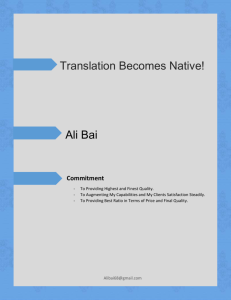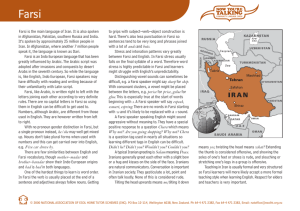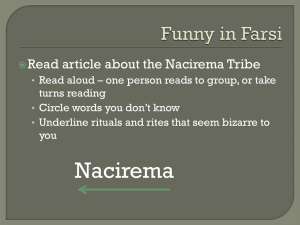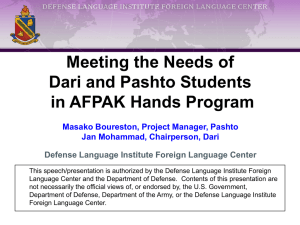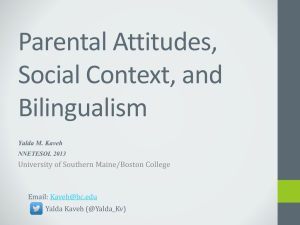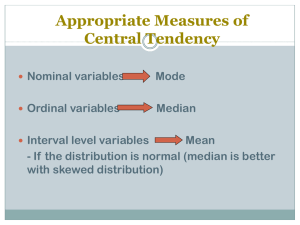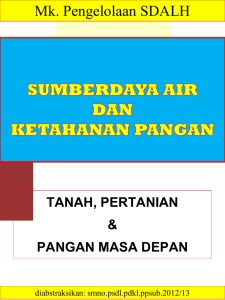AFPAK Learn Dari Dialectology
advertisement
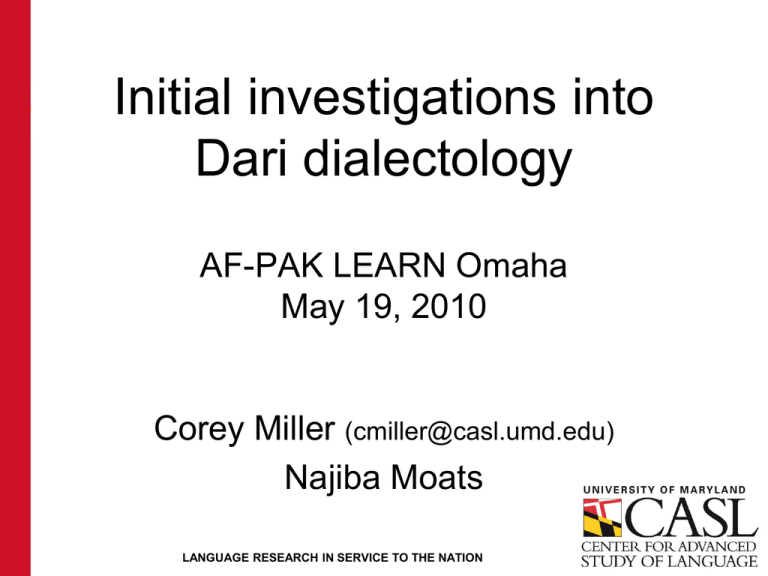
Initial investigations into Dari dialectology AF-PAK LEARN Omaha May 19, 2010 Corey Miller (cmiller@casl.umd.edu) Najiba Moats LANGUAGE RESEARCH IN SERVICE TO THE NATION What is Dari? Variety of Persian spoken in Afghanistan – Can be contrasted with Farsi (Iran), Tajik (Tajikistan) – We are not referring to the following usages: • Dialect of Zoroastrians spoken in Yazd and Kerman, Iran and Bombay, India • Literary form of Early New Persian (9-12th centuries) 2 LANGUAGE RESEARCH IN SERVICE TO THE NATION Southwest Iranian Languages Family Tree Old Persian Early New Persian Middle Persian Farsi 3 LANGUAGE RESEARCH IN SERVICE TO THE NATION Dari Tajik What is dialectology? • Study of variation in language associated with geography – Macro: national varieties of Persian – Micro: regional varieties within Farsi, Dari, etc. • Identification of dialect features associated with different localities – Words, pronunciations, grammatical features – Shibboleths and stereotypes 4 LANGUAGE RESEARCH IN SERVICE TO THE NATION Benefits to understanding dialectal structure of a language • Better understanding of non-standard language • Ability to determine a speaker’s provenance (à la Henry Higgins) 5 LANGUAGE RESEARCH IN SERVICE TO THE NATION How to describe Dari? • Contrastive approach – e.g. how does Dari differ from Farsi? • Internal approach – What are the popularly recognized dialects? (cf. Perceptual Dialectology, Dennis Preston) – Identify variables • What lexical, phonological, syntactic and morphological features characterize the different dialects? 6 LANGUAGE RESEARCH IN SERVICE TO THE NATION Lexical variables • Household items – sugar: بوره/bura/ vs. شکر/ʃakar/ – butter: مسکه/maska/ vs. کره/kare/ • Western imports: from French or English? – tie: نکتای/nektay/ vs. کراوات/krɑvɑt/ – Japan: جاپان/jɑpɑn/ vs. ژاپن/ʒɑpon/ • Same word different meaning – maternal uncle, midwife: ماما/mɑmɑ/, دائ/dɑi/ 7 LANGUAGE RESEARCH IN SERVICE TO THE NATION Phonological variables • Dari is generally more “conservative” – Preserves some distinctions (e.g. from Early New Persian) that are lost or merged in Farsi – Vowels – Diphthongs – Consonants 8 LANGUAGE RESEARCH IN SERVICE TO THE NATION Preservation of “classical” vowel distinctions • e~i – شیر/ʃer/ vs. /ʃir/ lion, شیر/ʃir/ milk – سیر/ser/ vs. /sir/ full, سیر/sir/ garlic • o~u – شور/ʃor/ vs. /ʃur/ salty – صور/sur/ trumpet Dari Farsi 9 i e i LANGUAGE RESEARCH IN SERVICE TO THE NATION u o u Preservation of diphthongs • ay ~ e – پیدا/paydɑ/ vs. /pedɑ/ find – سیر/sayr/ vs. /ser/ walking • aw ~ o – جلو/jelaw/ vs. /jelo/ front – چلو/čelaw/ vs. /čelo/ cooked rice Dari Farsi 10 ay e LANGUAGE RESEARCH IN SERVICE TO THE NATION aw o National distinctions in domestic flux Example word Kabuli Herati Tehrani شیرlion e e/i i پیداfind ay ay/e e دوستfriend o o/u u جلوfront aw aw/o o Adapted from Farhadi 1955 11 LANGUAGE RESEARCH IN SERVICE TO THE NATION Consonants /q/ قand /ɣ/ غ • Dari maintains distinction – )قار( قهر/qɑr/ anger vs. غار/ɣɑr/ hole – Farsi has merged /q/ and /ɣ/ as /ɢ/ with allophones [ɢ] initially and [ʁ] intervocalically • Hodge 1957 reports q ~ ɣ distinction in Kerman, Iran – Both Dari and Farsi have allophone [x] in certain contexts: وقت/waxt/, /vaxt/ time Dari Farsi 12 ɣ q LANGUAGE RESEARCH IN SERVICE TO THE NATION ɢ Additional consonantal differences • Consonantal و – نودninety /nawad/ vs. /navad/ – آوازsound /ɑwɑz/ vs. /ɑvɑz/ • ژj~ʒ – Farsi distinguishes ج/j/ and ژ/ʒ/ – Merged in Dari • ژاله/jɑla/ vs. / ʒɑle/ • جوان/javɑn/ youth 13 LANGUAGE RESEARCH IN SERVICE TO THE NATION Additional vocalic difference • vowel + “silent” ه – نامه/nɑma/ vs. /nɑme/ letter – شکسته/ʃekasta/ vs. /ʃekaste/ broken 14 LANGUAGE RESEARCH IN SERVICE TO THE NATION Syntactic and Morphological Differences • Morphology – first person singular verbal suffix: /om/ vs. /am/ • I go: /merom/ vs. /miram/ • Syntax – formation of the present progressive: I’m eating • خورده میرم/xorda merom/ • دارم می خورم/dɑram mixoram/ 15 LANGUAGE RESEARCH IN SERVICE TO THE NATION Methodology • Unlikely that differences in national varieties correspond exactly with political boundaries (cf. Miller 1985) • Use reported differences in national varieties to establish isoglosses 16 LANGUAGE RESEARCH IN SERVICE TO THE NATION 17 LANGUAGE RESEARCH IN SERVICE TO THE NATION 18 LANGUAGE RESEARCH IN SERVICE TO THE NATION Fieldwork components • Sociolinguistic interview • Elicitation guides – Phonology: reading wordlists – Lexicon: “What do you put in your tea to make it sweet?” • Reading passage – IPA Handbook Farsi adapted for Afghanistan – Observe connected speech processes 19 LANGUAGE RESEARCH IN SERVICE TO THE NATION 20 LANGUAGE RESEARCH IN SERVICE TO THE NATION Interviews to-date • Herat male • Mazari Sharif female (native language Uzbek) • Bamian female (Hazaragi) • Jalalabad male (native language Pashto) 21 LANGUAGE RESEARCH IN SERVICE TO THE NATION 22 LANGUAGE RESEARCH IN SERVICE TO THE NATION Plans going forward • Conduct interviews with speakers from additional regions • Deepen coverage of individual regions • “Standard”: determine existence, description and where it is found • Association of variables with localities: isoglosses • Determination and description of social dialects 23 LANGUAGE RESEARCH IN SERVICE TO THE NATION References • Farhadi, Abd-ul-Ghafur. 1955. Le persan parlé en Afghanistan. Paris: Klincksieck • Henderson, Michael Magnus Thyne. 1972. Dari (Kabul Persian) Phonology. Madison, WI: University of Wisconsin dissertation. • Hodge, Carleton T. 1957. Some aspects of Persian Style. Language 33.355-369. • International Phonetic Association. 1999. Handbook of the International Phonetic Association. Cambridge: Cambridge University Press. 24 LANGUAGE RESEARCH IN SERVICE TO THE NATION References • Miller, Corey. 1989. The United StatesCanadian border as a linguistic boundary: The English language in Calais, Maine and St. Stephen, New Brunswick. Cambridge, MA: Harvard College undergraduate thesis. • Nawid, Senzil. 1994. بررسی مختصر گویشهای دری کابل و فارسی تهران. Persian studies in North America: studies in honor of Mohammad Ali Jazayery. Bethesda, MD: Iranbooks. 25 LANGUAGE RESEARCH IN SERVICE TO THE NATION References • Preston, Dennis R., editor. 1999. Handbook of perceptual dialectology. Amsterdam: Benjamins. • Rees, Daniel A. 2008. Towards protoPersian: An optimality theoretic historical reconstruction. Washington, DC: Georgetown University dissertation. • Sayd, Mustafa Ajan. 2009. Dari-English Dictionary. Hyattsville, MD: Dunwoody. 26 LANGUAGE RESEARCH IN SERVICE TO THE NATION References .• فهرست واژه های متفاوت در فارسی افغانستان و ایران http://fa.wikipedia.org/wiki/%D9%81%D9%87 %D8%B1%D8%B3%D8%AA_%D9%88%D8 %A7%DA%98%D9%87%E2%80%8C%D9% 87%D8%A7%DB%8C_%D9%85%D8%AA% D9%81%D8%A7%D9%88%D8%AA_%D8% AF%D8%B1_%D9%81%D8%A7%D8%B1% D8%B3%DB%8C_%D8%A7%D9%81%D8% BA%D8%A7%D9%86%D8%B3%D8%AA%D 8%A7%D9%86_%D9%88_%D8%A7%DB%8 C%D8%B1%D8%A7%D9%86 27 LANGUAGE RESEARCH IN SERVICE TO THE NATION


